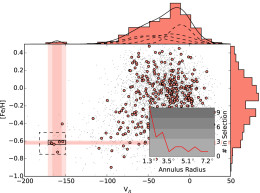Many satellites — dwarf galaxies and globular clusters — are thought to be orbiting our galaxy, but detecting them can be a tricky business. In particular, satellites can be disrupted by the galactic potential and spread out into streams, making them so diffuse that we’re unable to spot them in photometric observations.
In a recent study, a team of scientists led by John Vickers (Chinese Academy of Sciences) has cleverly worked around this difficulty by searching for groups of stars that have clustered velocities and metallicities differing from the background field.
Searching Through Stars

Radial velocity and metallicity of LAMOST stars near the physical location of Lamost 1. Circles are stars within 1.5° of the target location, small dots are stars within 5°. [Vickers et al. 2016]
Vickers and collaborators then compared the resulting set of 21 candidate streams to catalogs of known globular clusters, open clusters, and nearby galaxies. Three of the candidate clumps, clustered in a 3° area on the sky, do not correspond to any known objects. The authors postulate that these are all part of a disrupted satellite, which they dub Lamost 1.
Characterizing a Former Cluster
Fitting the spectroscopic data for the member stars, the authors are able to estimate a number of characteristics of Lamost 1, with the best fit implying an age of 11 Gyr, a total mass of about 20,000 solar masses, and a distance from us of about 8,500 light-years.
Based on the stellar motions, the authors believe that the clump is on an eccentric orbit and is currently at its furthest distance from the Galactic center. They suggest that the elliptic orbit and advanced age of the clump indicate it is most likely to be a disrupted globular cluster, rather than a dwarf galaxy.
Interestingly, when the authors went back to search for a stellar overdensity corresponding to Lamost 1 in photometric data, they were unable to detect it. This reaffirms that their approach of searching for velocity and metallicity clumping is an important tool for discovering otherwise-invisible diffuse streams.
Bonus
Check out this cool graphic Vickers made using Stellarium and Aladin to demonstrate where in the sky the stars of Lamost 1 are located. Lamost 1’s stars are the red dots in the constellation Draco.
Citation
John J. Vickers et al 2016 ApJ 816 L2. doi:10.3847/2041-8205/816/1/L2


